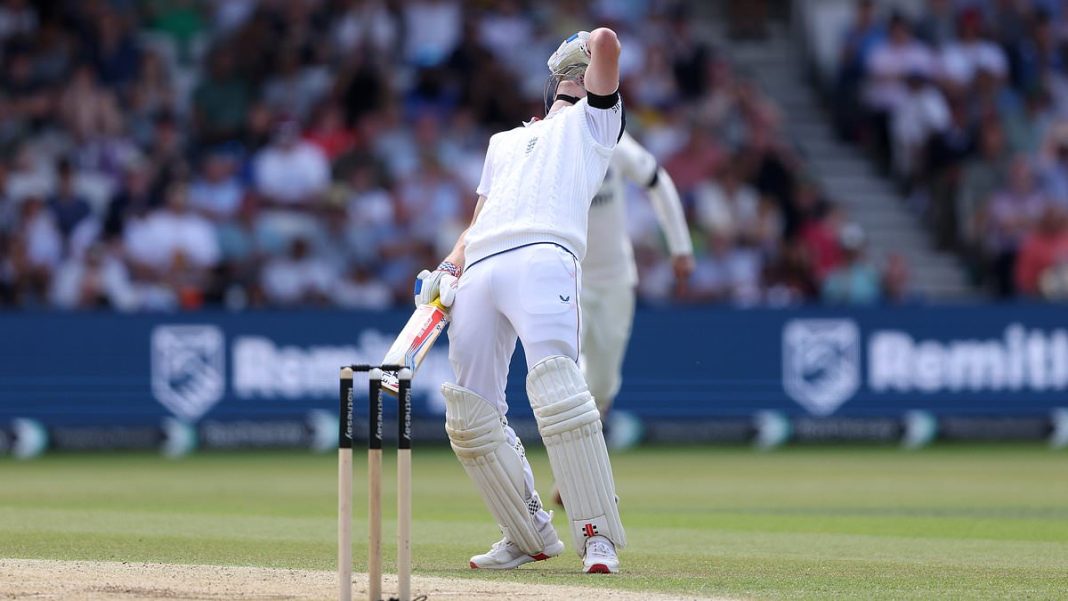In the corridors of the stand above the Kirkstall Lane End, Stuart Broad managed a wry smile when I told him I was trying to find Michael Atherton to ask him about the time he was run out on 99 against Australia at Lord’s in 1993. ‘I’m sure he’d be delighted to be reminded about that again,’ Broad said.
Atherton is a reluctant expert on the subject. He was also dismissed for 99, caught and bowled by South Africa’s Brian McMillan, here at Headingley, in August 1994. Only he and MJK Smith, among England players, have achieved the unwanted distinction of twice being dismissed one run short in a Test.
I tracked Atherton down in the end. He was sitting on the back row of the press box, welcoming Harry Brook in print to the list of unfortunates who have fallen one short of cricket’s magic number.
Atherton was phlegmatic. ‘You are consumed by the one you missed rather than the 99 you scored,’ he said.
It will be like that for Brook, whose batting had lit up a grey, blustery third day of this first Test. His crestfallen, horrified visage when he pulled a short ball from Prasidh Krishna straight into the clutches of Shardul Thakur at deep backward square, dismissed one run adrift of his century, testified to that.
Suddenly, it did not seem to matter that he had just played an innings of savage beauty, that he had smoked the India attack all around the ground, clubbing its bowlers into submission with 11 fours and two towering sixes, dragging England back into this match. All that mattered was that he was out for 99.
His dismissal made him the 81st player dismissed for 99 in Test cricket, the 14th Englishman and the first anywhere for three years since Travis Head fell for Australia against the West Indies in Perth. Jonny Bairstow had been the last England player to meet that fate, trapped lbw against South Africa at Old Trafford in August 2017.
Brook’s removal, by such an obvious, familiar old bowling trap, was part of a pattern of England players giving away their wickets unwisely here, and was made worse by the fact Headingley is his home ground.
Maybe the chance to score a Test century here in front of fans that adore him will come again to a player as prodigiously talented as he is. Maybe it won’t.
A century is such a random target in so many ways. And yet the difference between three figures and two bestows greatness on an innings and falling one short confers sporting tragedy upon it, as if it would have been better to have fallen far earlier than to have just missed the mark.
But cricket loves numbers. It obsesses about them. Not just in its statistics and its averages but in its staging posts.
They say 111, a Nelson, is unlucky because it resembles three stumps. The Australians regard 87 with unease because it is 13 short of a century. Zero is never good, either. Ninety-nine, though, is cricket’s number of the beast.
Perhaps it is also because it gives an opponent so much succour. It is almost better than getting someone out cheaply.
Getting a batsman out for 99 is a cause for unrestrained glee in the ranks of the opposition. It is as if there is great sustenance to be had from feasting on a player’s crushing disappointment. It is as if a humiliation has been visited upon the batsman, even though he has just spent several hours getting the better of a group of bowlers. It is wrapped up in the idea that when the prize that is coveted so much was there for the taking, the batsman lost his nerve and showed weakness.
Some find dark humour in the unfortunate’s fate. When Shane Warne slog-swept a ball from Daniel Vettori into the air and into the hands of Mark Richardson at the WACA in 2001, Richardson bowed theatrically to the crowd and Ricky Ponting admitted some of the Aussies were ‘laughing into their lockers’. Warne never did score a Test century.
It is too early for Brook to see the light side of what happened at Headingley, though he may reflect that things could have been worse. It seemed briefly on Saturday that he had been caught in the deep for a duck before it became clear the umpire had ruled Jasprit Bumrah’s delivery a no-ball.
He rode his luck on Sunday, too. He was dropped twice. His aberration on 99 levelled things up, though Brook may not have thought of it that way as India’s players rushed to congratulate Krishna and Thakur sprinted in from the boundary to join the celebrations. Brook’s face was a mask of incredulity at the shot he had just played.
He had watched the ball, first with trepidation and then despair, as he tracked its flight. When the catch was taken, he looked as if he could barely walk back to the pavilion. It is probably cricket’s longest walk, the walk of the man dismissed for 99, and Brook’s seemed to last an eternity.
The word ‘trudge’ was made for Brook’s walk. He looked like the embarrassed duck that Australian broadcasters flash up when a batsman is dismissed without scoring. At one point he even dropped his bat as he walked, as if he were losing his senses.
Rishabh Pant, India’s wicketkeeper, gave him a consoling pat as he ran to join his team-mates but Brook did not notice. Brydon Carse, the next batsman in, crossed with him near the boundary rope and half put an arm round him in consolation. Brook did not notice that, either. He is in the club now, like it or not.
Clem Hill, the first man to be dismissed for 99 in a Test against England at Melbourne in 1902, scored 98 and 97 in the next Test at Adelaide. Good for the average, good for the team, but poison to that pursuit of three figures that consumes Brook and every batsman who has followed Hill to the crease since.






